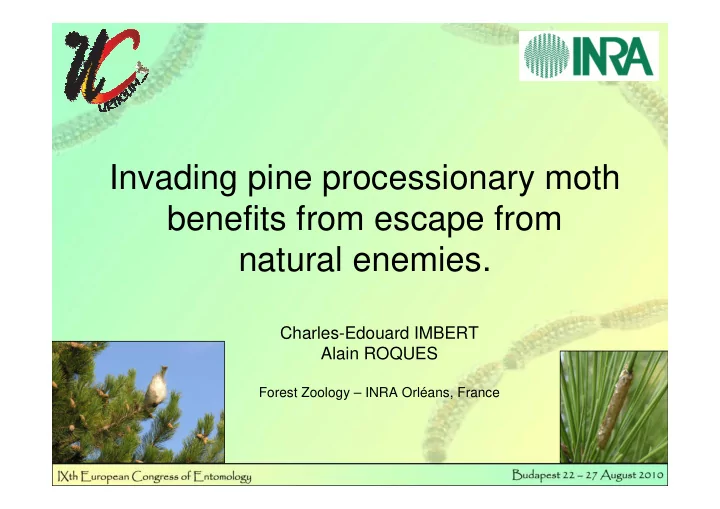

Invading pine processionary moth benefits from escape from natural enemies. Charles-Edouard IMBERT Alain ROQUES Forest Zoology – INRA Orléans, France
Climate change EEA Report No 4/2008 Global warming : Approximately + 0.6° C during the l ast century and between +1.4 and +5.8 ° C during this century. Effects on physiology Effects on phenology Effects on distributions
Study model The Pine Processionary Moth, Thaumetopoea pityocampa (Denis & Schiffermüller, 1775) (Lepidoptera, Notodontidae). Moth’s larvae grow during the winter and depend directly on temperature : - Death if T°around -16° C (depends on colony size) - Specific feeding requirements (night air temperature above 0° C and temperature inside the nest above 9° C on the preceding day)
Study model Robinet & al , 2007. Range distribution in constant progression northward (27 km per decade between 1972 et 2004) and in altitude. Artificially introduced populations above the front around Paris and in the east of France.
Study model 4 species of egg parasitoids reported in France Baryscapus servadeii (Eulophidae) Ooencyrtus pityocampae (Encyrtidae) Anastatus bifasciatus (Eupelmidae) Trichogramma sp (Trichogrammatidae)
General questions With the range expansion of the PPM we don’t know how the natural enemies and in particular the egg parasitoids will respond. � Differences in parasitism rate, specific richness, abundance, phenology along the expansion gradient ? � Do all species will respond in the same way ? � Same effect in latitudinal gradient than in altitudinal gradient ?
Sampling of egg-batches Paris Basin 6 sampling locations 157 egg-batches sampled Paris Basin transect French Alps transect Massif Central transect
Sampling of egg-batches French Alps 4 sampling locations 45 egg-batches sampled Paris Basin transect French Alps transect Massif Central transect
Sampling of egg-batches 8 sampling locations 102 egg-batches sampled Massif Central Paris Basin transect French Alps transect Massif Central transect
Analyze of eggs For each egg-batch, scales were Hatching hole of parasitoid removed after the hatch of parasitoids. Every egg without the characteristic hole of caterpillar hatching was open and parasitoid species was determined with the Hatching hole of caterpillar meconium after Tanzen and Schmidt (1995). Meconium of Ooencyrtus pityocampae at early stage (1) and late stage (2) of parasitism Meconium of Baryscapus servadeii
Results : Paris Basin 38356 eggs were analysed. Mann-Whitney test (p-value < 0.05) R²=0.04234 b b b a a a Significant differences between front populations and core populations. Parasitism rate is higher in core population than in front populations. No parasitoids found in artificially introduced populations.
Results : Paris Basin 3 parasites species were found B. servadeii , the specialist parasitoid of T. pityocampa is the only one found from core area to front area. Generalists parasitoids seem to have more difficulties to follow the pine processionary moth
Results : French Alps 9143 eggs were analysed. Mann-Whitney test (p-value < 0.05) R²: 0.1513 b b ab a Significantly higher parasitism in core populations than in front populations
Results : French Alps 4 parasitoid species found Two main parasitoids species : B. servadeii and O. pityocampae found in each sample locations. The rate of specialist parasitoid increase near the front populations.
Results : Massif Central 24218 eggs analysed Mann-Whitney test (p-value < 0.05) R²: 0.0381 c bc bc bc ab a Significant differences between front populations and core populations. Parasitism rate is higher in core population than in front populations.
Results : Massif Central 3 parasitoid species found Two main parasitoids species : B. servadeii and O. pityocampae found in each sample locations as in French Alps transect. The rate of specialist parasitoid decrease near the front populations
Conclusion/Perspectives In the 3 transects, latitudinal as altitudinal, we observed a reduction of parasitism near the range boundaries of pine processionary moth. Parasitism rate and species richness are different between the transects, we can’t explain that now. But it is only one year sampling so we can’t observe interanual variations. An other sampling has been done this year to complete these data. With less mortality because of egg-parasitism in the front area, the pine processionnary moth might have greater colonies that could provide a better survival during the winter and they could colonize more easily colder places.
Thank you for your attention ! ������������������ �������������� ��������������������� ������������������� �!�"#�$�������%�����������&'()�*�&+,�
Recommend
More recommend